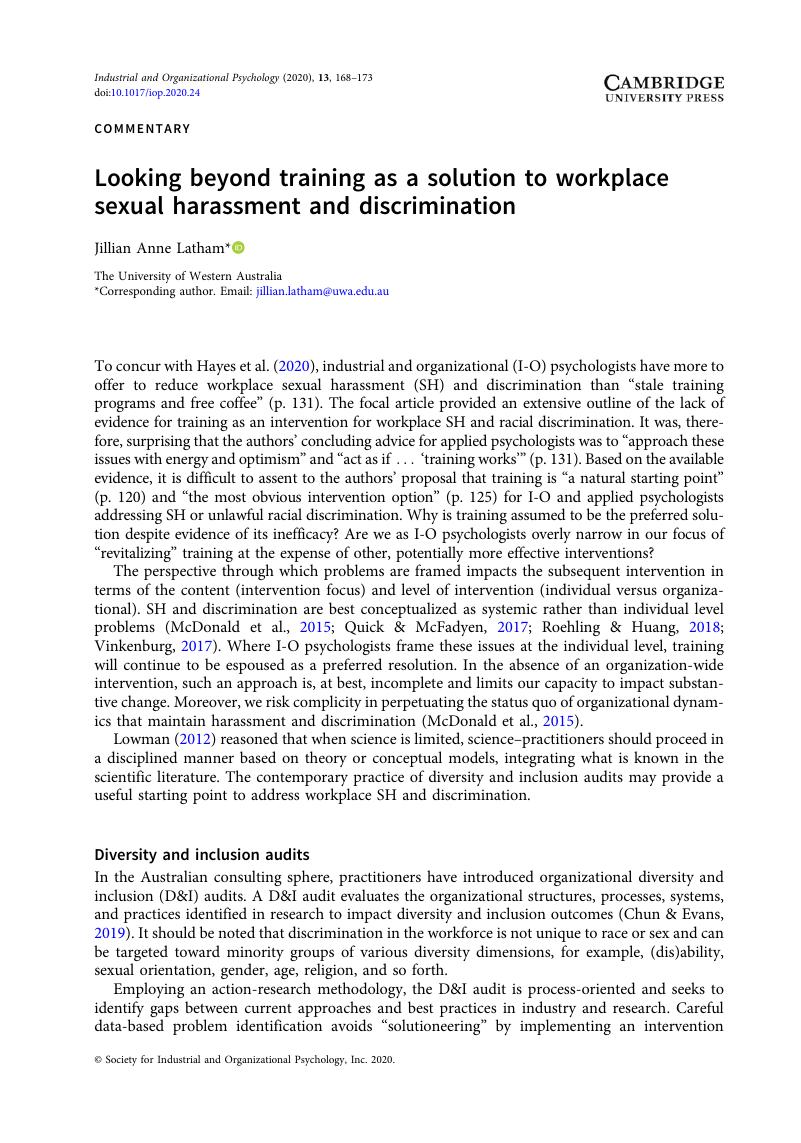No CrossRef data available.
Article contents
Looking beyond training as a solution to workplace sexual harassment and discrimination
Published online by Cambridge University Press: 28 July 2020
Abstract
An abstract is not available for this content so a preview has been provided. Please use the Get access link above for information on how to access this content.

- Type
- Commentaries
- Information
- Copyright
- © Society for Industrial and Organizational Psychology, Inc. 2020
References
Australian Human Rights Commission. (2018). Everyone’s business: Fourth national survey on sexual harassment in Australian workplaces. Retrieved from https://www.humanrights.gov.au/our-work/sex-discrimination/publications/everyones-business-fourth-national-survey-sexualGoogle Scholar
Bagdasarov, Z., Olson-Buchanan, J., & MacDougall, A. E. (2019). Improving sexual harassment and sexual assault training effectiveness by aligning training efforts with business strategy. Industrial and Organizational Psychology, 12, 84–88.CrossRefGoogle Scholar
Bezrukova, K., Spell, C. S., Perry, J. L., & Jehn, K. A. (2016). A meta-analytical integration of over 40 years of research on diversity training evaluation. Psychological Bulletin, 142, 1227–1274.CrossRefGoogle ScholarPubMed
Bohnet, I. (2016). What works: Gender equality by design. Cambridge, MA: Harvard University Press.CrossRefGoogle Scholar
Buengeler, C., Leroy, H., & De Stobbeleir, K. (2018). How leaders shape the impact of HR’s diversity practices on employee inclusion. Human Resource Management Review, 28, 289–303.CrossRefGoogle Scholar
Castilla, E. J. (2015). Accounting for the gap: A firm study manipulating organizational accountability and transparency in pay decisions. Organization Science, 26, 311–333.CrossRefGoogle Scholar
Chun, E., & Evans, A. (2019). Conducting an institutional diversity audit in higher education: A practitioner’s guide to systematic diversity transformation. Sterling, VA: Stylus Publishing, LLC.Google Scholar
Dobbin, F., Kim, S., & Kalev, A. (2011). You can’t always get what you need: Organizational determinants of diversity programs. American Sociological Review, 76, 386–411.CrossRefGoogle Scholar
Dover, T. L., Kaiser, C. R., & Major, B. (2020). Mixed signals: The unintended effects of diversity initiatives. Social Issues and Policy Review, 14, 152–181. doi: 10.1111/sipr.12059CrossRefGoogle Scholar
Hamilton, K. M., Snoeyink, M. J., & Martinez, L. R. (2019). Blurred lines: How to approach sexual harassment training when sexual harassment isn’t always about sex. Industrial and Organizational Psychology, 12(3), 345–349.CrossRefGoogle Scholar
Heilman, M. E., & Caleo, S. (2018). Combatting gender discrimination: A lack of fit framework. Group Processes & Intergroup Relations, 21, 725–744.CrossRefGoogle Scholar
Kaiser, C. R., Major, B., Jurcevic, I., Dover, T. L., Brady, L. M., & Shapiro, J. R. (2013). Presumed fair: Ironic effects of organizational diversity structures. Journal of Personality and Social Psychology, 104, 504–519.CrossRefGoogle ScholarPubMed
Kalev, A., Dobbin, F., & Kelly, E. (2006). Best practices or best guesses? Assessing the efficacy of corporate affirmative action and diversity policies. American Sociological Review, 71, 589–617.CrossRefGoogle Scholar
Kalysh, K., Kulik, C. T., & Perera, S. 2016. Help or hindrance? Work-life practices and women in management. Leadership Quarterly, 27(3), 504–518.CrossRefGoogle Scholar
Kaplan, R. S., & Norton, D. P. (1992). The balanced scorecard—measures that drive performance. Harvard Business Review, 70, 71–79.Google ScholarPubMed
Leslie, L. M. (2019). Diversity initiative effectiveness: A typological theory of unintended consequences. Academy of Management Review, 44, 538–563.CrossRefGoogle Scholar
Lowman, R. L. (2012). The scientist-practitioner consulting psychologist. Consulting Psychology Journal: Practice and Research, 64, 151–156.CrossRefGoogle Scholar
Madera, J. M., Lee, L., & Dawson, M. (2019). Sexual harassment and sexual assault training: Consider the industry. Industrial and Organizational Psychology, 12, 96–99.CrossRefGoogle Scholar
Magley, V. J., Fitzgerald, L. F., Salisbury, J., Drasgow, F., & Zickar, M. J. (2013). Changing sexual harassment within organizations via training interventions: Suggestions and empirical data. In Burke, R. & Cooper, C. (Eds.), The fulfilling workplace: The organization’s role in achieving individual and organizational health (pp. 225–246). Burlington, VT: Bower.Google Scholar
McDonald, P., Charlesworth, S., & Graham, T. (2015). Developing a framework of effective prevention and response strategies in workplace sexual harassment. Asia Pacific Journal of Human Resources, 53, 41–58.CrossRefGoogle Scholar
Quick, J. C., & McFadyen, M. (2017). Sexual harassment: Have we made any progress? Journal of Occupational Health Psychology, 22, 286–298.CrossRefGoogle ScholarPubMed
Roehling, M. V., & Huang, J. (2018). Sexual harassment training effectiveness: An interdisciplinary review and call for research. Journal of Organizational Behavior, 39, 134–150.CrossRefGoogle Scholar
Troiano, E. (2020, January 28). Topic overview: Diversity councils. Retrieved from https://www.catalyst.org/research/diversity-councils-overview/Google Scholar
Vinkenburg, C. J. (2017). Engaging gatekeepers, optimizing decision making, and mitigating bias: Design specifications for systemic diversity interventions. Journal of Applied Behavioral Science, 53, 212–234.CrossRefGoogle ScholarPubMed
Workplace Gender Equality Agency. (2019). Workplace flexibility. Retrieved from https://www.wgea.gov.au/topics/workplace-flexibilityGoogle Scholar


